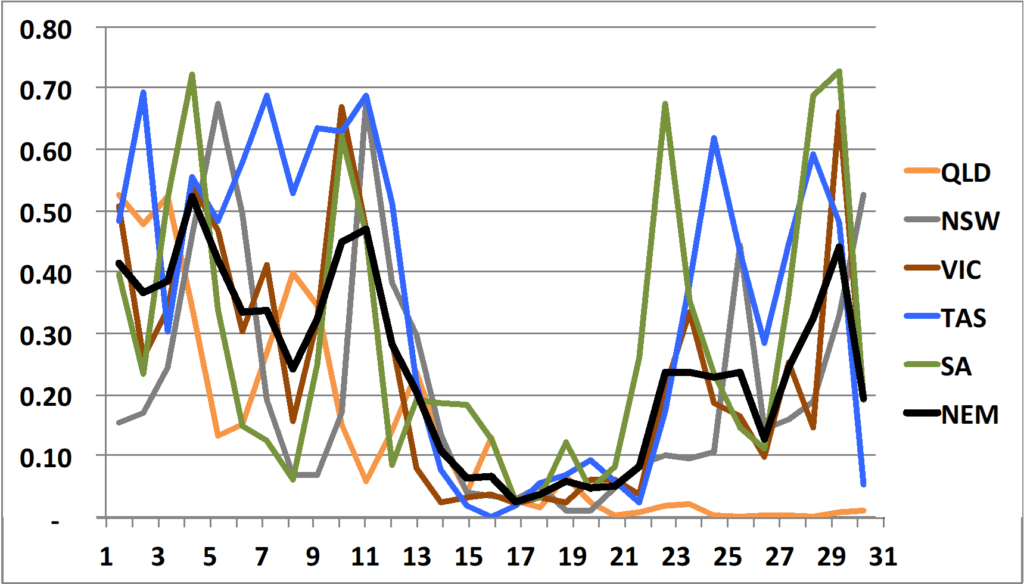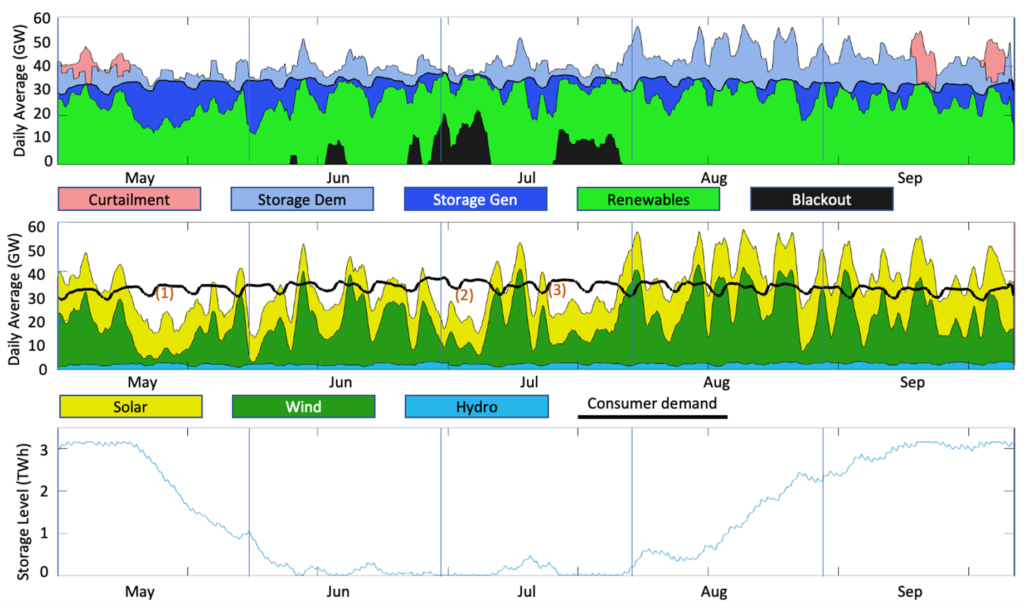If you are reading a paper on how to operate a grid in periods of low wind and solar, it probably means the current crisis has passed for now, or you may need a new hobby…
You might have heard the term wind drought or renewables drought used a bit recently, as there was a period in the last few months were both wind and solar outputs were well below average. Despite the current authors having used that term a bit, we would like to introduce a slightly nuanced term, low wind and solar seasons. You see, we have modelled a few renewable droughts in the NEM, and yes, you need a lot of storage to get through this (and it’s good to see some other folks are now catching up with our earlier work on large storage on the NEM – YES, you need a LOT of Snowy’s…). Our classic renewable drought runs for two weeks in the middle of May 2010 – however, we have found recently it is not just the single event that NEM needs to get through. It is actually ‘seasons’ of low wind and solar periods that are the most taxing on the system.
These periods of low wind or wind droughts have seemingly occurred for as long as wind has been measured and recorded (note the term Doldrums for you sailor types). Sometimes these droughts affect small areas of the NEM and sometimes they can cover multiple states. These droughts have lasted for a day or two, or sometimes even longer than a week. But more importantly – these ‘events’ or ‘droughts’ are often embedded within a longer season of low renewable output.
What does that mean for the NEM? As we move towards a system more dependent on wind and solar, what level and type of storage will be required? What other grid services are also required to ensure grid reliability and security? Noting, that the answer to this question should seek to ensure that the lowest system cost is achieved (or close to it at least) to minimise consumers’ bills and taxpayers’ burden.
In a paper published in early 2022, we (Andy Boston and Geoff Bongers) undertook an analysis of renewable droughts (Characterisation and Mitigation of Renewable Droughts in the Australian National Electricity Market). This analysis reviewed 15 years of climate and electricity demand data to examine the both the frequency as well as the nature of the occurrence of low renewable periods. One of the findings was that the NEM is susceptible to these droughts during winter period, May to August, which is in line with the drought we have observed. A stress test of May 2010 is a great demonstration of a wind drought that stretches across all five States of the NEM.
For a fuller examination of the technical bits that underpin the analysis – check out the paper or our report on storage.

Wind load factors in May 2010 showing nature of NEM wide wind drought.
However, while this renewable drought requires much planning and a strong and prepared NEM to get through it – the bigger issue is that if such a drought is part of a prolonged low wind and solar output ‘season.’ This was very much the case in 2010, which suffered a train of wind droughts throughout the winter with little time to recover between them. Here we have found the scale of the issue beyond a solution based on a just ‘add storage’ approach. Even making the heroic assumption that States are strongly interconnected and operate as a selfless part of NEM requires significant levels of renewable overbuild, large levels of storage and backup firm generation. One of the high renewable scenarios we modelled had 140GW of wind and solar, 10 x Snowy 2.0’s, perfect interconnection and still required 20 GW of thermal backup plant used throughout June and July to survive the winter without loss. Poor interconnection or lack of co-ordination between the States will greatly increase the need for storage and thermal backup.

Performance of the NEM subject to 2010 weather with 20% renewable overbuild, 10 x Snowy 2.0’s, perfect interconnection and harmonious action by the States showing persistence of renewable drought from May to August.
It’s clear that planning for suitable generation to carry the NEM through these infrequent low output seasons is key and will shape the system as a whole. We look forward to being part of the discussion on what a robust, reliable, low emissions, and lowest total system cost NEM might look like.
About our Guest Authors
| Geoff Bongers is an Adjunct Professor at the University of Queensland in Brisbane. He is also a director at Gamma Energy Technology P/L, an independent energy consulting company. The main focus of his work is on the technoeconomics of energy production and modelling energy systems to understand what the optimum energy transitions look like. He holds a PhD from Monash University, Melbourne, Australia.
You can find Geoff on LinkedIn here.
Andy Boston is the director at Red Vector, an energy consultancy for modelling electricity markets, integration of renewables, whole systems analysis, techno-economics, and business games. He is the developer of the MEGS model and co-founder of Heuristic with its portfolio of business games for Power Trading, Transport Planning and R&D Impact. You can find Andy on Linkedin here.
Nathan Bongers is an engineer working at Gamma Energy Technology P/L. Since graduating with a Bachelor of Engineering from the Queensland University of Technology, he has been focusing on energy generating systems to help bring about an optimum energy transition. You can find Nathan on LinkedIn here. |


Very interesting and important, suggesting that it may be winter wind droughts that will set the amount of storage required, rather than the maybe more widely studied wind lulls in summer, in association with heatwave induced demand spikes, which often in the past didn’t cause problems because they fell on public holidays.
Solar has a daily drought of course, but must play a role during daylight hours in replenishing the storage, and preventing it from becoming fully drained.
“We look forward to being part of the discussion on what a robust, reliable, low emissions, and lowest total system cost NEM might look like.” Good luck with that, there must be a huge tendency to bury the bad news of possible future problems.